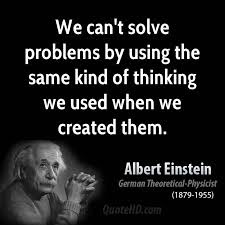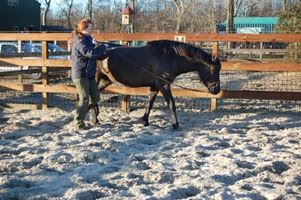Clicker training is brain training. I simply have to break out of the box of conventional ideas to come up with solutions that are ethical (pain free and force free) and horse friendly (easy to understand and rewarding for the horse). This is not always a simple task with these self-imposed regulations.
Challenge
Sometimes it is a real challenge to come up with solutions for difficulties I encounter in  my own training with Kyra. If I work for a client it’s really easy, because I am the outsider. To come up with creative training solutions for my own situation is much more challenging. That is why I like to have a mentor too.
my own training with Kyra. If I work for a client it’s really easy, because I am the outsider. To come up with creative training solutions for my own situation is much more challenging. That is why I like to have a mentor too.
If my mentor is not available, I have to focus on what I want and how I want this instead of ‘how I know I can solve this’. Because ‘I know how to solve this’ with coercion, negative reinforcement, punishment and other methods I am not willing to use anymore.
Training goal
Kyra is up for a new step in her training on the long reins. I want her to canter on the long reins. That means she has to learn to collect herself, otherwise I can’t keep up with her.
I started her on a circle in canter because she was too fast. On a circle I didn’t have to run. I created a problem by staying on the circle too long. She didn’t want to follow the rail on the long side of the arena, because she thought she had to stay in a circle.
Couldn’t you just use the outside rein?
 I didn’t want to pull on the outside rein. Her head moves up and down a lot in canter so the reins are already moving and causing too much ‘noise’ to be subtle with the rein aids. I don’t want to pull (force) her with the reins since I think the reins should stay a subtle aid.
I didn’t want to pull on the outside rein. Her head moves up and down a lot in canter so the reins are already moving and causing too much ‘noise’ to be subtle with the rein aids. I don’t want to pull (force) her with the reins since I think the reins should stay a subtle aid.
Pulling on the outside reins causes her body to bend the wrong way (outside ‘Stellung’) which is a hard problem to solve later.
Why didn’t you use the whip to prevent her coming off the track?
I don’t use a whip. This would only work if she is used to yielding for the whip and/or is afraid of the whip. Using a tool that is developed to cause pain, discomfort or help motivate (in a negative reinforcement way) a horse move is not what I want. I think it can be too enticing to use it for what it is made for in a moment of frustration.
I don’t want to teach Kyra what she is NOT supposed to do (she is ‘not supposed to come off track’), I want her to teach what I want her to do: stay on the track. It is a different way of thinking. Focusing on what you want to teach instead of what you want to prevent.
How did you solve it if you don’t use rein aids or a whip?
Thank you for asking! I had to figure out a way to communicate to Kyra what it is I was looking for: staying on the track in canter.
Step 1
First I laid some poles next to the track parallel to the wall on the long side of the arena. She just stepped over them to make her circle. So I split the goal into smaller steps: I practised cantering at liberty and under saddle along the poles. That made it easier for her to understand that she was suppose to follow the track. It wasn’t fool proof and she was still confused on the long rein.
Step 2
Then I used some cones which she knows how to target. I made it really easy and asked her to touch the cone then canter a few strides to the next cone and asked her to touch that other cone. She understood quickly and so I made the distance between the cones bigger. The poles were still parallel to the track but she didn’t want to jump over them now that she was focused on the cones.
 Step 3
Step 3
Now we made really quick progress: she started to canter on the long side of the track. In 3 training sessions of 5-10 minutes I could take some of the poles away and start cantering on the other side of the arena on the long side.
Step 4
The next step was to fade out the cones and the two poles at the beginning and end of the long sides of the tracks. The cones were not important anymore because now I could click and reinforce for cantering on the track.
Step 5
Now I started to canter on the other side of the arena as well and it was no problem for her to understand to stay on the track.
Step 6
The next step is to change reins and practise everything she now learned in the left lead canter to the right lead canter.
Step 7
Now we are working on speed in canter. She is still a bit too fast and she has to learn to collect more so I can walk along her side instead of jogging. We already worked on this in session 4 and 5.
In this way I taught Kyra to stay on track and canter more slowly in only 7 sessions of 5-10 minutes. No frustration (only a bit of a brainteaser for me), no force, pain or threatening. I really like to come up with training solutions like this so I don’t have to damage the bond of trust I have been building so carefully.
What are some of the force free and R+ solutions you came up with in your training?
Please share this post if it was helpful. It might help other equestrians to think out of the box.
Sandra Poppema
Are you interested in online my online course Set Your Equestrian Goals & Achieve them click here for more info


Pingback: Debunking Myths: ‘The Whip is only an Extension of my Arm’ – Equine Clicker Training